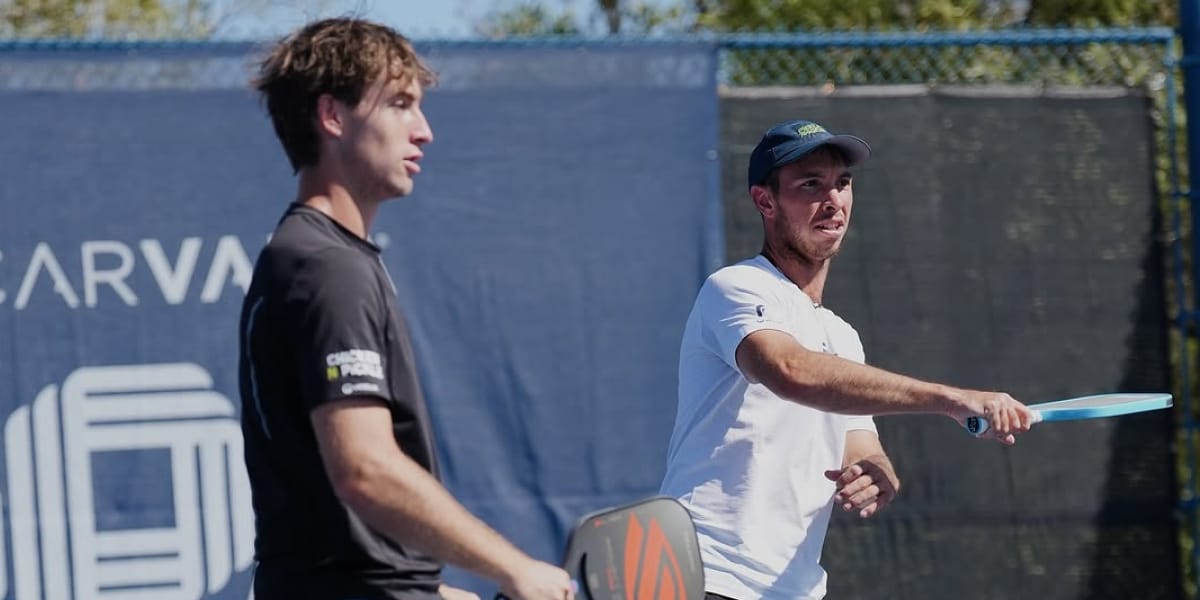
Midwestern sensation Dylan Frazier has changed how the right side is played. Pickleball teams need to provide offense and aggression from the right, and Dylan explains why.
An Outgoing Philosophy of a Submissive Right-Side
Traditional philosophy suggests that two right-handed players do not naturally share the court 50/50 because of how the right arm attaches at the shoulder, which limits its reach across the body.
If a right-handed player is playing on the left side of the court, their forehand can cover past the center line and control the middle of the court more efficiently, which, by virtue, controls the dinking exchange.
In contrast, the right-side player reaches across their body to cover the middle with their backhand, which tends to be a weaker position to dictate the action.
Additionally, the right-side player's left foot is often a target for opponents at the kitchen line.
This is because of the awkward angle required to hit a backhand dink across one’s body. The left-side player can alleviate this pain point by stepping into the middle and taking that shot.
Dylan notes that the above reasoning is why the right-side player has traditionally “stepped back and given the left-side player space to exert control over the rally.”
Pickleball is a Young Sport
Though this sport was invented in 1965, it has never had as many players with an incentive to devise the most optimal way to play out a point as it does now.
Dylan notes that even for a mature sport like basketball, it took years before the idea that a team centered around the three-point shot could win more games. Additionally, the forward pass was used sparingly in the early days of football, but now teams with a balanced air and ground game are the teams to beat.
Innovation From The Right
A similar balance may be in store for pickleball as more teams experiment with a more pronounced right-side role. Ben and Collin Johns, who have had great success in the sport for many years, made the left-side dominant role a game staple. However, as the field improves, players are increasingly experimenting with how a stronger right-side presence can provide a strategic advantage.

How it Started
“I am not going to say we were the first, but we may have been one of the first to experiment with a more 50/50 right side left side role”, Dylan said. “I asked myself, “Why should I ever take a backhand hit to my left foot when I can move to the center of the court and take that shot with my forehand?”
A 50/50 presence also has a positioning advantage over a left-side dominant team. “One weakness in an otherwise technically sound game is that Ben takes so much court and can get caught out of position, which has hurt them in the past few tournaments,” Dylan suggests.

How it’s Going
What started as a 50/50 share of the court is now getting pushed even further. “I think players like Gabe Tardio and Hayden Patriquin have taken the lead in taking it one step further and are almost playing a dominant “alpha” right side role.”
Dylan notes that this dominant right-side role can best be illustrated in Federico Staksrud partnerships with Hayden and Gabe. Federico, by no means less capable, can settle into the left side of the court and keep a more steady presence. This allows him to set up points for his right-side partner by having his feet set to be more aggressive with his cross-court dinks while reducing dinking errors on longer, more grinding rallies.
“Gabe is particularly problematic for the left-side player across the net from him. Gabe is almost straddling the midline, and with his height, he is taking a lot of balls out of the air, virtually eliminating his left foot as a target,” Dylan describes.
That said, if opponents hit to his right to keep Gabe honest with a dink down his line, he can make them pay for it.
“Gabe has a lethal and deceptive forehand attack off the bounce. He is almost baiting players to dink down his line where he can go almost anywhere with his forehand attack, not to mention his ability to Erne any ball hit too close to the sideline.”
Change is Constant
Dylan predicts that players will inevitably find ways to adapt to this right-side dominant strategy. “This may involve dinking more aggressively down the line or lobbing them.”
“Players will adapt to this new right-side role relatively quickly,” Dylan suggests. Then, there will be an adaptation to that adaptation, and so on and so on.
“The future of pickleball will probably get to a point where teams can execute any given strategy of right or left dominance based on the matchup.” Then, it will come down to execution.
Covering the middle from the right is no easy task, and each of the top players who attempt it does it a little differently. That said, it's all about consistency at the end of the day.
“My advice to players, from amateurs to professionals, is to learn the basics and build consistency. Consistency on basic shots wins games at all levels,” Dylan notes. Without consistency, it’s hard to execute any given strategy.
And that’s advice we can all use, whichever side of the court we find ourselves on!

John Sanders
John Sanders is a PPR-certified instructor who can be reached at ThePickleProf.com. He helps players navigate their pickleball addiction with weekly tips on etiquette, technique, & injury prevention.
Love Pickleball? Join 100k+ readers for free weekly tips, news & gear deals.
Subscribe to The DinkGet 15% off pickleball gear at Midwest Raquet Sports









